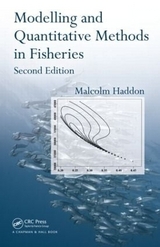
Modelling and Quantitative Methods in Fisheries
Crc Press Inc (Verlag)
978-1-58488-177-3 (ISBN)
- Titel erscheint in neuer Auflage
- Artikel merken
Quantitative methods and mathematical modelling are of critical importance to fishery science and management but, until now, there has been no book that offers the sharp focus, methodological detail, and practical examples needed by non-specialist fishery scientists and managers, and ecologists. Modelling and Quantitative Methods in Fisheries fills that void.
To date, methodology books in fisheries science have been limited to cookbook approach to problems; simple compilations; or expositions in which either too much theory or insufficient methodological detail is given. The text is organized into three sections: an introduction to modelling in fisheries and ecology, a straight methodology section covering a range of methods, and a section focusing on specific fields in fisheries science. This book is timely as it addresses a topic of recent debate in fisheries and ecology, describing and comparing the uses of Least Squares, Maximum Likelihood, and Bayesian quantitative methods.
Designed as stand-alone units, each chapter provides examples from both classic and recent literature and comes with dedicated Excel spreadsheets that permit you to delve into every detail of the analysis. All of these spreadsheets serve as active examples, which can easily be modified and customized and can be used as templates for analyzing your own data. The spreadsheets permit you to learn at your own speed and cover the simplest linear regression to the more complex non-linear modelling using maximum likelihood.
Data analysis and modelling are best learned by doing and not just by reading. This book illustrates, step by step, the analyses it covers. More detailed in terms of introductory quantitative methods and modelling as applied to fisheries than any other book available, Modelling and Quantitative Methods in Fisheries gives you the advantage by supplying the full details of the analysis so that understanding the material is a matter of following the book.
FISHERIES, POPULATION DYNAMICS, AND MODELLING
The Formulation of Fish Population Dynamics
Equilibrium vs. Non-Equilibrium
Characteristics of Mathematical Models
Types of Model Structure
SIMPLE POPULATION MODELS
Assumptions - Explicit and Implicit
Density - Independent Growth
Density - Dependent Models
Responses to Fishing Pressure
The Logistic Model in Fisheries
Age-Structured Models
Simple Yield-per-Recruit
MODEL PARAMETER ESTIMATION
Models and Data
Least-Squared Residuals
Non-Linear Estimation
Likelihood
Bayes' Theorem
COMPUTER INTENSIVE METHODS
Resampling
Randomization Tests
Jackknife Methods
Bootstrapping Methods
Monte Carlo Methods
Relationships Between Methods
Computer Programming
RANDOMIZATION TESTS
Hypothesis Testing
Randomization of Structured Data
STATISTICAL BOOTSTRAP METHODS
The Jackknife and Pseudo-Values
The Bootstrap
Bootstrap Statistics
Bootstrap Confidence Intervals
MONTE CARLO MODELLING
Monte Carlo Models
Practical Requirements
A Simple Population Model
A Non-Equilibrium Catch-Curve
GROWTH OF INDIVIDUALS
Growth in Size
Von Bertalanffy Growth Model
Alternatives to Von Bertalanffy
Comparing Growth Curves
Concluding Remarks
STOCK-RECRUITMENT RELATIONSHIPS
Recruitment and Fisheries
Stock-Recruitment Biology
Beverton-Holt Recruitment Model
Ricker Model
Deriso's Generalized Model
Residual Error Structure
The Impact of Measurement Errors
Environmental Influences
Recruitment in Age-Structured Models
Concluding Remarks
SURPLUS-PRODUCTION MODELS
Introduction
Equilibrium Methods
Surplus-Production Models
Observation Error Estimates
Beyond Simple Models
Uncertainty of Parameter Estimates
Risk Assessment Projections
Practical Considerations
Age-Structured Models
Types of Models
Cohort Analysis
Statistical Catch-at-Age
APPENDIX A: The Use of Excel in Fisheries
BIBLIOGRAPHY
| Erscheint lt. Verlag | 31.5.2001 |
|---|---|
| Zusatzinfo | 100 equations; 9 Tables, black and white; 100 Illustrations, black and white |
| Verlagsort | Bosa Roca |
| Sprache | englisch |
| Maße | 156 x 235 mm |
| Gewicht | 612 g |
| Themenwelt | Mathematik / Informatik ► Mathematik |
| Weitere Fachgebiete ► Land- / Forstwirtschaft / Fischerei | |
| ISBN-10 | 1-58488-177-1 / 1584881771 |
| ISBN-13 | 978-1-58488-177-3 / 9781584881773 |
| Zustand | Neuware |
| Haben Sie eine Frage zum Produkt? |
aus dem Bereich



